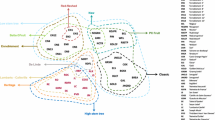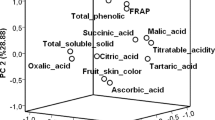Abstract
In the present work, a comparative study of the detailed phenolic profile of fruit and juice samples from an Asturian cider apple breeding program was carried out. To achieve this, a fast, selective and sensitive UHPLC-DAD strategy was developed and validated. The proposed method allowed determining 49 polyphenols in apple samples and 41 phenolic compounds in apple juice samples in 18 min. Furthermore, six minor flavonoids have been quantified for the first time in apples: phloretin-hexosyl-hexoside, isorhamnetin-3-O-galactoside, isorhamnetin-3-O-glucoside, isorhamnetin-3-O-arabinopyranoside, isorhamnetin-3-O-arabinofuranoside and isorhamnetin-3-O-rhamnoside. The selectivity and reliability of this methodology allowed us to apply it in a successful manner to select the most interesting descendants from a progeny of ‘Meana’ × ‘Florina’ (a cider and a dessert apple, respectively) in terms of their phenolic composition. Descendants X9701-349, 119, 370, 120 and 069 could be proposed for cider production, since they exhibited a higher phenolic content than ‘Meana’ apple juice. Although flavan-3-ol, procyanidin and dihydrochalcone levels were similar to those observed in ‘Meana’ apple, flavonol levels increased slightly. Furthermore, it is worth noting that hydroxycinnamic acid concentration was up to three times higher. This fact could lead to an increase in cider astringency and color, as well as in cider aroma. Thus, this methodology is proposed to be applicable to the determination of the phenolic profile in other fruit and/or plant extracts.



Similar content being viewed by others
References
Khanizadeh S, Tsao R, Rekika D, Yang R, Charles MT, Vasantha-Rupasinghe HP (2008) Polyphenol composition and total antioxidant capacity of selected apple genotypes for processing. J Food Compos Anal 21:396–401
Lea AGH (2003) In: Lea AGH, Piggot JR (eds) Fermented beverage production, 2nd edn. Blackie Academic and Proffesional, London
Beveridge T (1997) Haze and cloud in apple juices. Crit Rev Food Sci Nutr 37:75–91
Amiot MJ, Tacchini M, Aubert S, Nicolas J (1992) Phenolic composition and browning susceptibility of various apple cultivars at maturity. J Food Sci 57:958–962
Picinelli-Lobo A, Rodríguez-Madrera R, Mangas-Alonso JJ (2005) A study of cider distillates using sensory and chromatographic data and chemometric analysis. J Food Sci 70:S204–S207
Cowan MM (1999) Plant products as antimicrobial agents. Clin Microbiol Rev 12:564–582
Lea AGH (1990) In: Rouseff R (ed) Bitterness in food and beverages. Elsevier, The Netherlands
Wojdyło A, Oszmiański J, Laskowski P (2008) Polyphenolic compounds and antioxidant activity of new and old apple varieties. J Agric Food Chem 56:6520–6530
Verdu CF, Childebrand N, Marnet N, Lebail G, Dupuis F, Laurens F, Guilet D, Guyot S (2014) Polyphenol variability in the fruits and juices of a cider apple progeny. J Sci Food Agric 94:1305–1314
Guyot S, Marnet N, Sanoner P, Drilleau J- (2003) Variability of the polyphenolic composition of cider apple (Malus domestica) fruits and juices. J Agric Food Chem 51:6240–6247
Van der Sluis AA, Dekker M, De Jager A, Jongen WMF (2001) Activity and concentration of polyphenolic antioxidants in apple: effect of cultivar, harvest year, and storage conditions. J Agric Food Chem 49:3606–3613
Hagen SF, Borge GIA, Bengtsson GB, Bilger W, Berge A, Haffner K, Solhaug KA (2007) Phenolic contents and other health and sensory related properties of apple fruit (Malus domestica Borkh., cv. Aroma): effect of postharvest UV-B irradiation. Postharvest Biol Technol 45:1–10
Napolitano A, Cascone A, Graziani G, Ferracane R, Scalfi L, Di Vaio C, Ritieni A, Fogliano V (2004) Influence of variety and storage on the polyphenol composition of apple flesh. J Agric Food Chem 52:6526–6531
Dapena E, Blázquez MD (2004) Improvement of the resistance to scab, rosy apple aphid and fire blight in a breeding programme of cider apple cultivars. Acta Hortic 663:725–728
Kahle K, Kraus M, Richling E (2005) Polyphenol profiles of apple juices. Mol Nutr Food Res 49:797–806
Suárez B, Palacios N, Fraga N, Rodríguez R (2005) Liquid chromatographic method for quantifying polyphenols in ciders by direct injection. J Chromatogr A 1066:105–110
Cielecka-Piontek J, Zalewski P, Jelinska A, Garbacki P (2013) UHPLC: the greening face of liquid chromatography. Chromatographia 76:1429–1437
Alonso-Salces RM, Barranco A, Corta E, Berrueta LA, Gallo B, Vicente F (2005) A validated solid-liquid extraction method for the HPLC determination of polyphenols in apple tissues: comparison with pressurised liquid extraction. Talanta 65:654–662
Ramírez-Ambrosi M, Abad-García B, Viloria-Bernal M, Garmón-Lobato S, Berrueta LA, Gallo B (2013) A new ultrahigh performance liquid chromatography with diode array detection coupled to electrospray ionization and quadrupole time-of-flight mass spectrometry analytical strategy for fast analysis and improved characterization of phenolic compounds in apple products. J Chromatogr A 1316:78–91
Hill L, Wang TL (2009) In: Osbourn AE, Lanzotti V (eds) Plant-derived natural products: synthesis, function, and application. Springer, New York
Abad-García B, Berrueta LA, López-Márquez DM, Crespo-Ferrer I, Gallo B, Vicente F (2007) Optimization and validation of a methodology based on solvent extraction and liquid chromatography for the simultaneous determination of several polyphenolic families in fruit juices. J Chromatogr A 1154:87–96
Picinelli Lobo A, García YD, Sánchez JM, Madrera RR, Valles BS (2009) Phenolic and antioxidant composition of cider. J Food Compos Anal 22:644–648
Janovitz-Klapp AH, Richard FC, Goupy PM, Nicolas JJ (1990) Inhibition studies on apple polyphenol oxidase. J Agric Food Chem 38:926–931
Lea AGH, Arnold GM (1978) The phenolics of ciders: bitterness and astringency. J Sci Food Agric 29:478–483
Siebert KJ, Carrasco A, Lynn PY (1996) Formation of protein-polyphenol haze in beverages. J Agric Food Chem 44:1997–2005
Mangas JJ, Rodríguez R, Suárez B, Picinelli A, Dapena E (1999) Study of the phenolic profile of cider apple cultivars at maturity by multivariate techniques. J Agric Food Chem 47:4046–4052
Naish M, Clifford MN, Birch GG (1993) Sensory astringency of 5-O-caffeoylquinic acid, tannic acid and grape-seed tannin by a time-intensity procedure. J Sci Food Agric 61:57–64
Heresztyn T (1986) Metabolism of volatile phenolic compounds from hydroxycinnamic acids by Brettanomyces yeast. Arch Microbiol 146:96–98
Lea AGH (1992) In: Hemingway RW, Laks PE (eds) Plant polyphenols: synthesis, properties, significance. Plenum Press, UK
Beech FW, Carr JG (1977) In: Rose AH (ed) Economic microbiology, vol 1: alcoholic beverages. Academic Press, UK
Ceymann M, Arrigoni E, Schäarer H, Baumgartner D, Nising AB, Hurrell RF (2011) Rapid high performance screening method using UHPLC-MS to quantify 12 polyphenol compounds in fresh apples. Anal Method 3:1774–1778
Oszmianski J, Lee CY (1991) Enzymatic oxidation of phloretin glucoside in model system. J Agric Food Chem 39:1050–1052
Lancaster JE, Grant JE, Lister CE, Taylor MC (1994) Skin color in apples—influence of copigmentation and plastid pigments on shade and darkness of red color in five genotypes. J Am Soc Hortic Sci 119:63–69
Thielen C, Will F, Zacharias J, Dietrich H, Jacob H (2004) Polyphenols in apples: distribution of polyphenols in apple tissue and comparison of the fruit with apple juice. Dtsch Lebensm-Rundsch 100:389–398
Matthes A, Schmitz-Eiberger M (2009) Polyphenol content and antioxidant capacity of apple fruit: effect of cultivar and storage conditions. J Appl Bot Food Qual 82:152–157
Chinnici F, Bendini A, Gaiani A, Riponi C (2004) Radical scavenging activities of peels and pulps from cv. Golden Delicious apples as related to their phenolic composition. J Agric Food Chem 52:4684–4689
Acknowledgments
This research was supported by Gobierno Vasco/Eusko Jaularitza (project number IT413-10) and Plan Nacional de I + D+I 2008-2011 (project number RTA2012-00118-C03-03, financed by INIA and co-financed by FEDER funds). María Ramírez-Ambrosi thanks Universidad del País Vasco/Euskal Herriko Unibertsitatea (UPV/EHU) for financial support (Contratación de Doctores Recientes hasta su Integración en Programas de Formación Postdoctoral, Vicerrectorado de Investigación) and Gobierno Vasco/Eusko Jaurlaritza for her Ph.D. Grant. Technical and staff support provided by SGIker (UPV/EHU, MICINN, GV/EJ, ESF) is gratefully acknowledged.
Author information
Authors and Affiliations
Corresponding author
Ethics declarations
Conflict of interest
None.
Ethical Standard
This article does not contain any studies with human or animal subjects.
Electronic supplementary material
Below is the link to the electronic supplementary material.
217_2015_2502_MOESM1_ESM.xlsx
Supplementary material 1 The parameters of the regression equations for the polyphenols used for quantification purpose (XLSX 12 kb)
217_2015_2502_MOESM2_ESM.xlsx
Supplementary material 2 A detailed description of the phenolic profile of the 22 apple (data expressed as mg/kg DW ± standard error, n = 3) (XLSX 27 kb)
217_2015_2502_MOESM3_ESM.xlsx
Supplementary material 3 A detailed description of the phenolic profile of the 22 apple juice samples (data expressed as mg/L ±standard error, n = 3) (XLSX 1213 kb)
Rights and permissions
About this article
Cite this article
Ramírez-Ambrosi, M., López-Márquez, D.M., Abad-García, B. et al. Comparative study of phenolic profile of fruit and juice samples of a progeny of ‘Meana’ × ‘Florina’ from an Asturian cider apple breeding program. Eur Food Res Technol 241, 769–784 (2015). https://doi.org/10.1007/s00217-015-2502-2
Received:
Revised:
Accepted:
Published:
Issue Date:
DOI: https://doi.org/10.1007/s00217-015-2502-2




